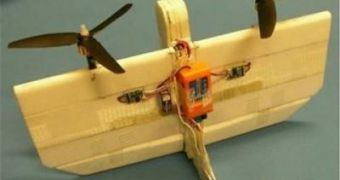A French researcher has managed to design a new, rugged micro air vehicle (MAV) that has immediately sparked the interest of the US Air Force (USAF) because of its maneuverability and high-aerodynamic performances. The aircraft is able to maintain its superior operating parameters even when it flies through unfavorable weather – wind, rain, fog, clouds, and so on. The work was funded by the European Office of Aerospace Research and Development (EOARD), in London, England, and the French DoD.
“The global vision for developing the bimotor MAVion is to provide a fixed-wing aircraft that can be easily upgraded for hover, but also for rolling on the ground or along walls by adding wheels on either side,” the creator of the new MAV explains. Dr. Jean-Mars Moschetta is a professor of aerodynamics at the Institut Superieur de l'Aeronautique et de l'espace, in Toulouse, France. The 30-centimeter, fixed-wing aircraft has been dubbed MAVion (avion stands for airplane in French).
The innovation is powered by two counter-rotating propellers, which enable it to switch from flying forward at high speeds to hovering in a short period of time. Investors from both the military and the commercial sectors have expressed their interest in this design, which could come in handy to emergency response teams in disaster areas, for example. Outfitted with cameras, the MAV would make for a potent observation tool and could help the personnel reach victims faster and more efficiently.
“The ultimate goal of the MAVion concept is to demonstrate a twofold capability using the same vehicle: fast forward flight and hover flight. The two counter-rotating tandem propellers provide a simple means to enhance yaw control, which is particularly important in vertical flight,” the expert adds. Earlier this year, at the Fourth Annual International Micro Air Vehicle Flight Competition, held in Pensacola, Florida, the new MAV won top honors for its performances.
“This innovative, MAVion, with its simplistic design, may have a potential for both military and civil applications in the future,” EOARD Chief of Aeronautical Sciences Dr. Surya Surampudi concludes of the new project. The expert has also been its overseer.

 14 DAY TRIAL //
14 DAY TRIAL //